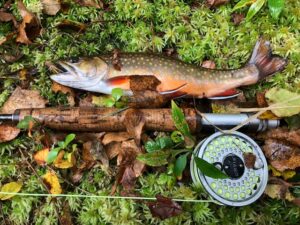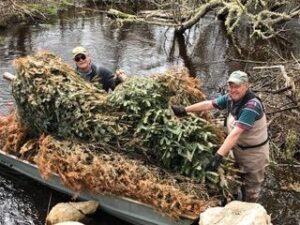About the Quashnet River Valley
The Quashnet river winds through the towns of Mashpee and Falmouth for about five miles, starting at John’s Pond in Mashpee and eventually becoming the Moonakis River and emptying into Waquoit Bay. It is located within the Mashpee National Wildlife Refuge and is a popular spot for recreation including hiking and fishing. Native brook trout are a popular species with anglers, and these fish need cold water streams and gravel substrates for spawning (laying their eggs). Sea-run brook trout, also known as “salters,” spawn in rivers and streams in the fall, migrate into salt water for the winter, and then swim back upstream in the spring. When the water becomes too warm in the Waquoit Bay estuary for the Quashnet brook trout, they swim back upstream. According to Fran Smith, cold water streams are defined as anything less than 68 degrees Fahrenheit, and anything over about 70 degrees is dangerous for the fish. During spawning, they push the gravel away with their tails, lay their eggs, and then push the gravel back over them. The Quashnet provides crisp, flowing water that is ideal for these hardy fish, as well as an abundance of food like glass shrimp and insects. In addition to brook trout, it also supports other wildlife like herring, eels, heron, otter, and songbirds.

Brook trout. Photo sourced from the Trout Unlimited Website.
History and Degradation
When it was untouched by the hands of developers, the Quashnet supplied important resources to the Wampanoag tribe and provided ideal habitat for salter brook trout. However, deforestation and development would be the first step towards its eventual degradation. Developments included saw and grist mills that prevented trout and herring from migrating. Then, cranberry growers moved into the area around 1895 and converted the Quashnet into a large system of cranberry bogs, which involved filling in the river with sand to provide a surface on which to plant and grow cranberries. Many of the growers also used harmful pesticides. However, the cranberry industry took a major hit in the 1950s due to flooding, a devastating hurricane, and a herbicide leak in 1959. As a result, many of the growers abandoned their bogs.
The building of the cranberry bogs and their eventual abandonment had a devastating impact on the Quashnet and its brook trout population. Excess sediment reduced stream flow and caused the river to become shallower and wider. There was also an overgrowth of brushy vegetation, including a shrub called sweet gale. The sweet gale and other brush formed a canopy over the river, and eventually collapsed into it, creating barriers to water flow and fish passage. The collapse of vegetation also pulled sediment from the river’s banks into the water. The abundant sediment and vegetation choked the river and prevented sea-run fish from migrating, which led to declines in brook trout populations. In short, “one of the finest trout streams on Cape Cod” had become a “brush-choked remnant of ancient times” (Keay).
Restoration and Additional Projects
Work began in the late 1970s to restore the Quashnet to its previous condition and bring back the native brook trout. Trout Unlimited, the group that has spearheaded these efforts, is a national organization dedicated to conserving and protecting cold-water trout and salmon fisheries. In 1973, biologist Joseph Bergin from the Massachusetts Department of Fisheries and Wildlife took part in a study where he looked into the water quality and trout stocks of the Quashnet. However, he had difficulty capturing fish due to excess vegetation and sediment in the water. As a result, he began partnering with Trout Unlimited to clear an 800-foot section of the river. However, the group found that once they started clearing the river, they could not stop, and the project since has turned into an over 40-year endeavor. Francis Smith from Trout Unlimited, along with a group of dedicated volunteers, have been a part of restoration efforts from the very beginning. When speaking with Fran about his experience leading the restoration, he told me that all of the work has been done by hand without the help of machines like excavators and bulldozers. It has also been an all-volunteer project. To achieve their goals, Trout Unlimited volunteers have put substantial amounts of time into removing brush like sweet gale, planting grasses to stabilize the riverbank, planting trees to provide shade and reduce water temperatures, and installing devices like deflectors and artificial underwater banks to provide cover for fish and eliminate excess sediments. As a result of these efforts, brook trout populations have increased from one trout for every 100 feet to about a couple hundred for the same amount of distance. Additionally, Trout Unlimited has been involved in scientific research on brook trout including electroshocking surveys and PIT tagging. Electroshocking allows them to capture fish for study, and the PIT tags monitor the fish’s movements.
The Quashnet has faced challenges since the restoration efforts began, including the failure of a berm in 1999 that was meant to contain chemical pollution from the Massachusetts Military Reservation. The failure of the berm had similar effects to the conversion of the river into cranberry bogs, such as slowed water flow, river widening, overgrowth of vegetation, increases in water temperature, and a loss of trout habitat. However, dedicated volunteers are still meeting regularly to restore the upper portion of the river, and the project is still very much alive and well. Various development projects have also threatened the Quashnet, such as the proposed building of condominiums and a high school, but Fran and other dedicated individuals have strongly opposed these efforts.
Although the Quashnet River has received a large amount of attention, it is not the only project which has sought to convert old cranberry bogs into suitable wildlife habitat, a process called “rewilding.” In 2016, work began to convert two cranberry bogs near the Child’s River into wetland habitat, and more recently in 2023, there was a proposal to transform the 6.5-acre Chop Chaque cranberry bog near Santuit Pond in Mashpee into wetlands. These projects will entail the removal of culverts, dams, excess sediment, and vegetation. In the past, natural wetland environments were destroyed to create commercial cranberry bogs, and the hope is that converting abandoned bogs into wetlands will return lost wildlife habitat. The fact that so much has been done to transform unused land shows that improving the natural environment is a priority for many. With the aid of concerned citizens and dedicated volunteers, these projects should continue to produce successful results.

Volunteers working on restoration efforts. Image sourced from Trout Unlimited website.
Additional Resources:
-Would you like to help restore the upper Quashnet? Visit this page to learn more: https://www.capecodtu.org/quashnet-restoration/
-Research at the Reserve presentation about brook trout and the Quashnet River:
https://www.youtube.com/watch?v=6jOoIj8J_rw
-Cape Cod Trout Unlimited Newsletter: Contains monthly updates about the restoration of the Upper Quashnet and can be accessed by visiting this link: https://www.capecodtu.org/newsletter/
Sources and Credits:
-Much of the information contained in this article was sourced from The History of the Quashnet River Valley by Donald Keay and a 1988 article from Trout Magazine titled “Quashnet River Restoration”
-Thank you to Fran Smith for talking with me and providing me with additional insight and resources
-Thanks to Tim Lynch for letting me use images from Cape Cod Trout Unlimited’s website
Article Written by Grace Vachon
